KIA Sportage 2017 QL / 4.G Owner's Manual
Manufacturer: KIA, Model Year: 2017, Model line: Sportage, Model: KIA Sportage 2017 QL / 4.GPages: 595, PDF Size: 16.22 MB
Page 571 of 595
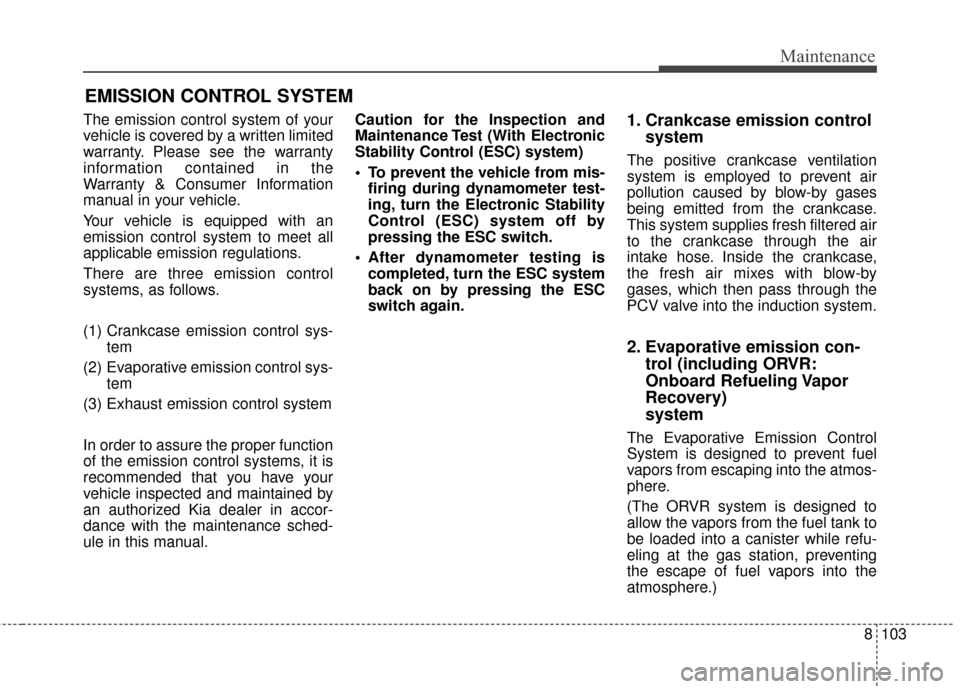
8103
Maintenance
EMISSION CONTROL SYSTEM
The emission control system of your
vehicle is covered by a written limited
warranty. Please see the warranty
information contained in the
Warranty & Consumer Information
manual in your vehicle.
Your vehicle is equipped with an
emission control system to meet all
applicable emission regulations.
There are three emission control
systems, as follows.
(1) Crankcase emission control sys-tem
(2) Evaporative emission control sys- tem
(3) Exhaust emission control system
In order to assure the proper function
of the emission control systems, it is
recommended that you have your
vehicle inspected and maintained by
an authorized Kia dealer in accor-
dance with the maintenance sched-
ule in this manual. Caution for the Inspection and
Maintenance Test (With Electronic
Stability Control (ESC) system)
To prevent the vehicle from mis-
firing during dynamometer test-
ing, turn the Electronic Stability
Control (ESC) system off by
pressing the ESC switch.
After dynamometer testing is completed, turn the ESC system
back on by pressing the ESC
switch again.1. Crankcase emission control system
The positive crankcase ventilation
system is employed to prevent air
pollution caused by blow-by gases
being emitted from the crankcase.
This system supplies fresh filtered air
to the crankcase through the air
intake hose. Inside the crankcase,
the fresh air mixes with blow-by
gases, which then pass through the
PCV valve into the induction system.
2. Evaporative emission con-trol (including ORVR:
Onboard Refueling Vapor
Recovery)
system
The Evaporative Emission Control
System is designed to prevent fuel
vapors from escaping into the atmos-
phere.
(The ORVR system is designed to
allow the vapors from the fuel tank to
be loaded into a canister while refu-
eling at the gas station, preventing
the escape of fuel vapors into the
atmosphere.)
Page 572 of 595
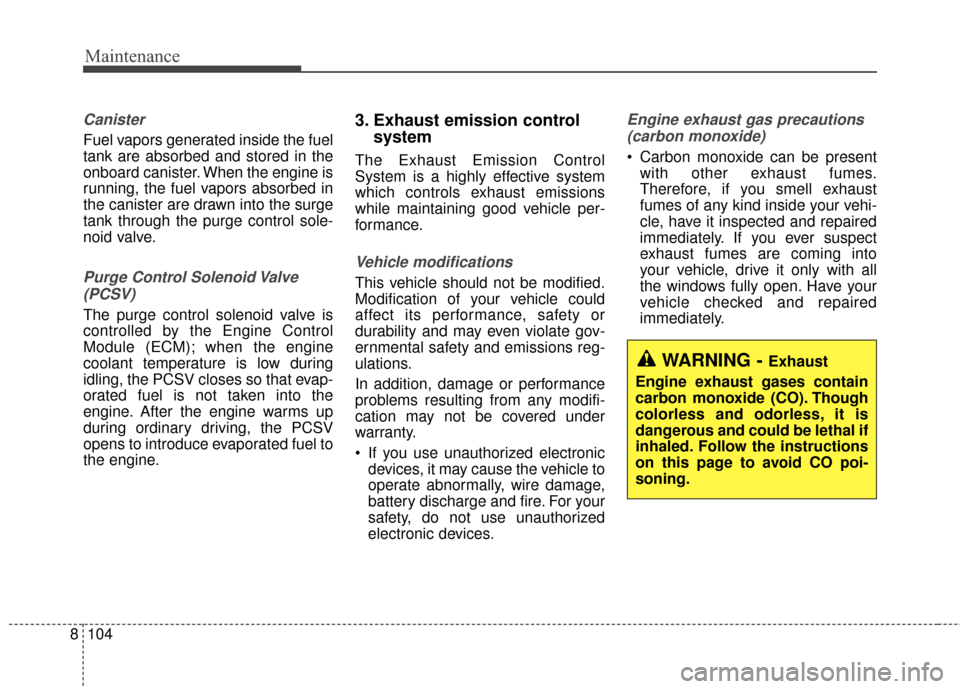
Maintenance
104
8
Canister
Fuel vapors generated inside the fuel
tank are absorbed and stored in the
onboard canister. When the engine is
running, the fuel vapors absorbed in
the canister are drawn into the surge
tank through the purge control sole-
noid valve.
Purge Control Solenoid Valve
(PCSV)
The purge control solenoid valve is
controlled by the Engine Control
Module (ECM); when the engine
coolant temperature is low during
idling, the PCSV closes so that evap-
orated fuel is not taken into the
engine. After the engine warms up
during ordinary driving, the PCSV
opens to introduce evaporated fuel to
the engine.
3. Exhaust emission control system
The Exhaust Emission Control
System is a highly effective system
which controls exhaust emissions
while maintaining good vehicle per-
formance.
Vehicle modifications
This vehicle should not be modified.
Modification of your vehicle could
affect its performance, safety or
durability and may even violate gov-
ernmental safety and emissions reg-
ulations.
In addition, damage or performance
problems resulting from any modifi-
cation may not be covered under
warranty.
If you use unauthorized electronic
devices, it may cause the vehicle to
operate abnormally, wire damage,
battery discharge and fire. For your
safety, do not use unauthorized
electronic devices.
Engine exhaust gas precautions
(carbon monoxide)
Carbon monoxide can be present with other exhaust fumes.
Therefore, if you smell exhaust
fumes of any kind inside your vehi-
cle, have it inspected and repaired
immediately. If you ever suspect
exhaust fumes are coming into
your vehicle, drive it only with all
the windows fully open. Have your
vehicle checked and repaired
immediately.
WARNING - Exhaust
Engine exhaust gases contain
carbon monoxide (CO). Though
colorless and odorless, it is
dangerous and could be lethal if
inhaled. Follow the instructions
on this page to avoid CO poi-
soning.
Page 573 of 595
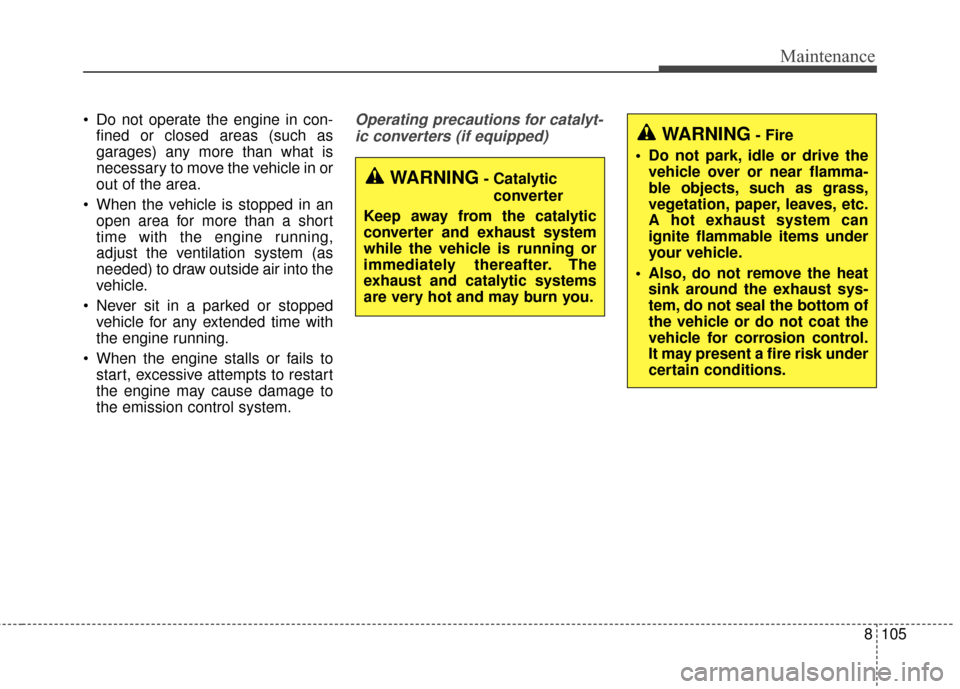
8105
Maintenance
Do not operate the engine in con-fined or closed areas (such as
garages) any more than what is
necessary to move the vehicle in or
out of the area.
When the vehicle is stopped in an open area for more than a short
time with the engine running,
adjust the ventilation system (as
needed) to draw outside air into the
vehicle.
Never sit in a parked or stopped vehicle for any extended time with
the engine running.
When the engine stalls or fails to start, excessive attempts to restart
the engine may cause damage to
the emission control system.Operating precautions for catalyt-
ic converters (if equipped)
WARNING- Catalytic converter
Keep away from the catalytic
converter and exhaust system
while the vehicle is running or
immediately thereafter. The
exhaust and catalytic systems
are very hot and may burn you.
WARNING- Fire
Do not park, idle or drive the vehicle over or near flamma-
ble objects, such as grass,
vegetation, paper, leaves, etc.
A hot exhaust system can
ignite flammable items under
your vehicle.
Also, do not remove the heat sink around the exhaust sys-
tem, do not seal the bottom of
the vehicle or do not coat the
vehicle for corrosion control.
It may present a fire risk under
certain conditions.
Page 574 of 595
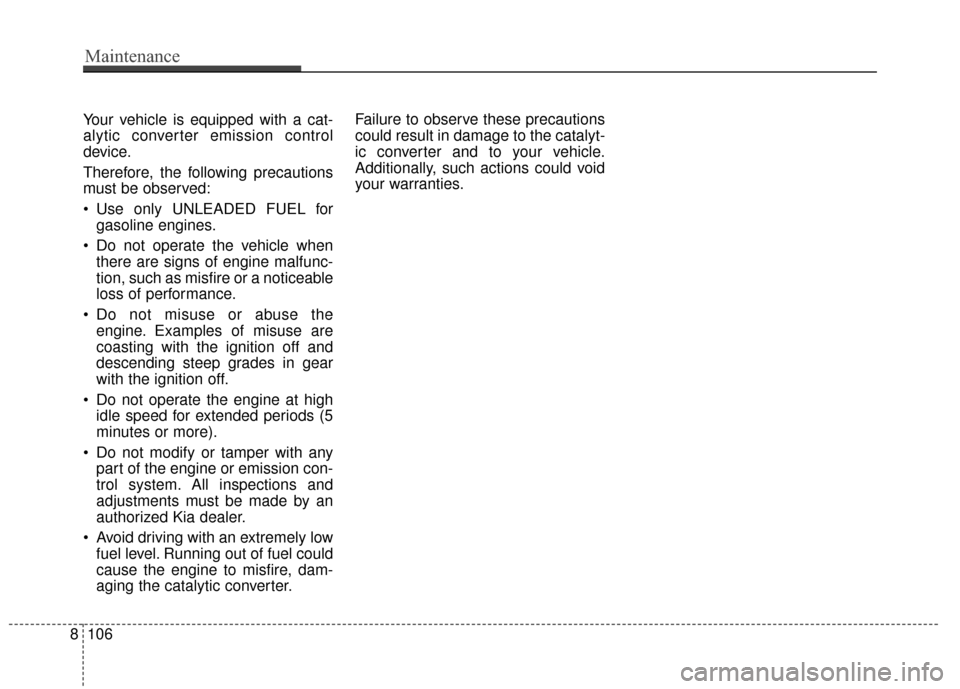
Your vehicle is equipped with a cat-
alytic converter emission control
device.
Therefore, the following precautions
must be observed:
Use only UNLEADED FUEL forgasoline engines.
Do not operate the vehicle when there are signs of engine malfunc-
tion, such as misfire or a noticeable
loss of performance.
Do not misuse or abuse the engine. Examples of misuse are
coasting with the ignition off and
descending steep grades in gear
with the ignition off.
Do not operate the engine at high idle speed for extended periods (5
minutes or more).
Do not modify or tamper with any part of the engine or emission con-
trol system. All inspections and
adjustments must be made by an
authorized Kia dealer.
Avoid driving with an extremely low fuel level. Running out of fuel could
cause the engine to misfire, dam-
aging the catalytic converter. Failure to observe these precautions
could result in damage to the catalyt-
ic converter and to your vehicle.
Additionally, such actions could void
your warranties.
8106
Maintenance
Page 575 of 595
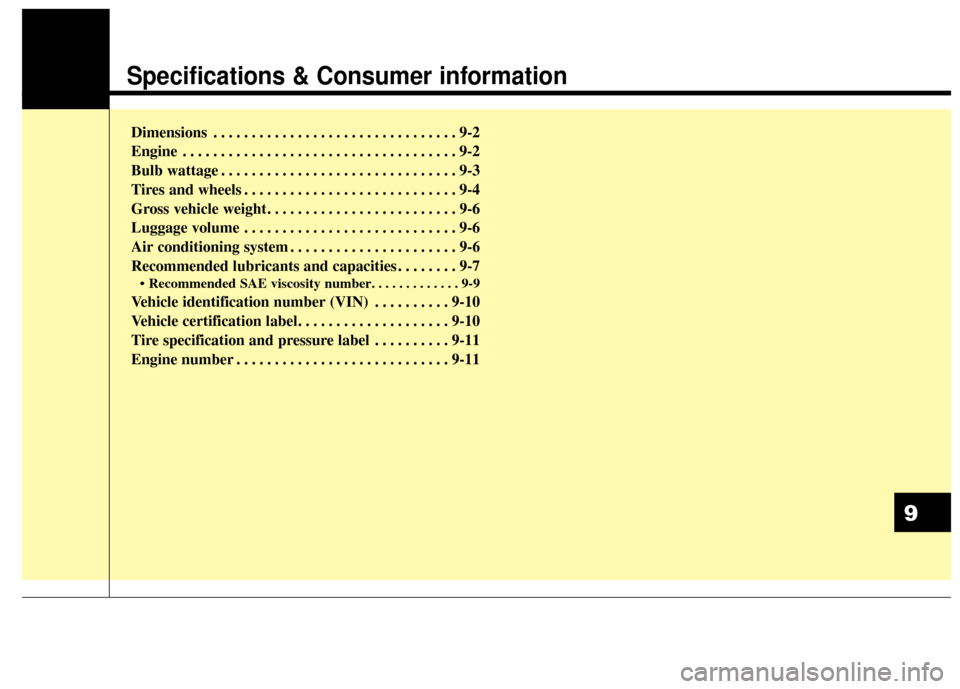
Specifications & Consumer information
Dimensions . . . . . . . . . . . . . . . . . . . . . . . . . . . . . . . . 9-2
Engine . . . . . . . . . . . . . . . . . . . . . . . . . . . . . . . . . . . . \
9-2
Bulb wattage . . . . . . . . . . . . . . . . . . . . . . . . . . . . . . . 9-3
Tires and wheels . . . . . . . . . . . . . . . . . . . . . . . . . . . . 9-4
Gross vehicle weight. . . . . . . . . . . . . . . . . . . . . . . . . 9-6
Luggage volume . . . . . . . . . . . . . . . . . . . . . . . . . . . . 9-6
Air conditioning system . . . . . . . . . . . . . . . . . . . . . . 9-6
Recommended lubricants and capacities . . . . . . . . 9-7
• Recommended SAE viscosity number. . . . . . . . . . . . . 9-9
Vehicle identification number (VIN) . . . . . . . . . . 9-10
Vehicle certification label. . . . . . . . . . . . . . . . . . . . 9-10
Tire specification and pressure label . . . . . . . . . . 9-11
Engine number . . . . . . . . . . . . . . . . . . . . . . . . . . . . 9-11
9
Page 576 of 595
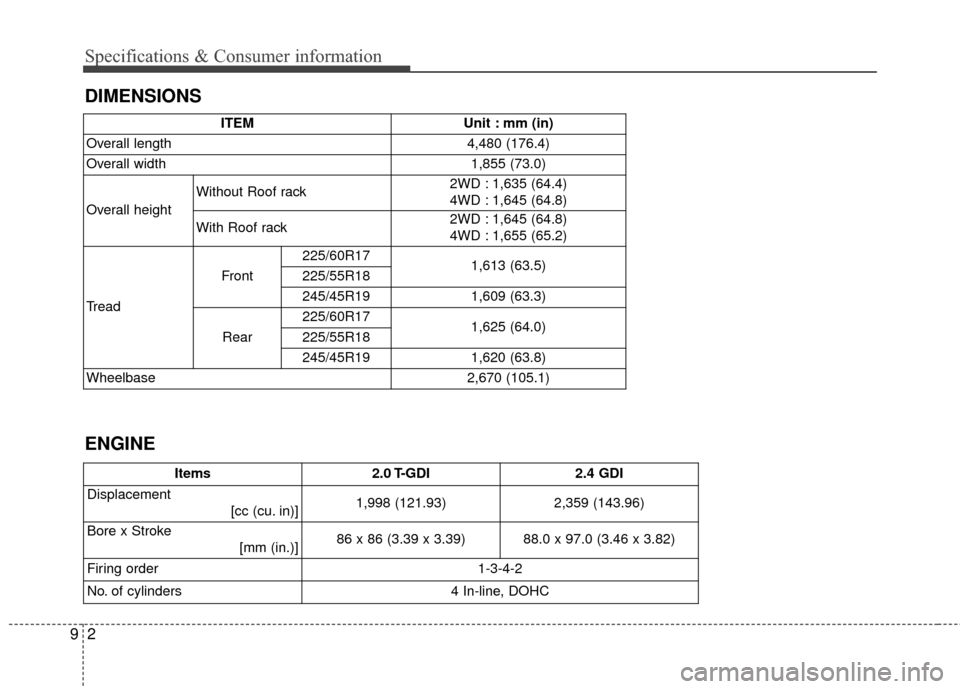
29
DIMENSIONS Specifications & Consumer information
ENGINE
ITEMUnit : mm (in)
Overall length4,480 (176.4)
Overall width1,855 (73.0)
Overall height
Without Roof rack2WD : 1,635 (64.4)
4WD : 1,645 (64.8)
With Roof rack2WD : 1,645 (64.8)
4WD : 1,655 (65.2)
Tread
Front
225/60R171,613 (63.5)225/55R18
245/45R191,609 (63.3)
Rear
225/60R171,625 (64.0)225/55R18
245/45R191,620 (63.8)
Wheelbase2,670 (105.1)
Items 2.0 T-GDI2.4 GDI
Displacement[cc (cu. in)]1,998 (121.93)2,359 (143.96)
Bore x Stroke [mm (in.)]86 x 86 (3.39 x 3.39)88.0 x 97.0 (3.46 x 3.82)
Firing order1-3-4-2
No. of cylinders4 In-line, DOHC
Page 577 of 595
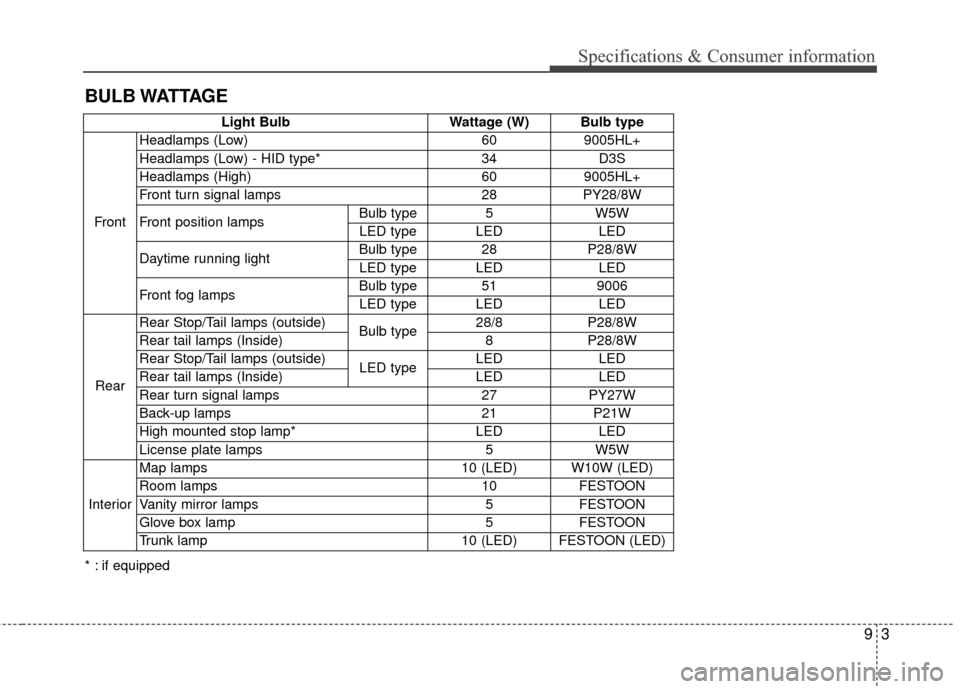
93
BULB WATTAGESpecifications & Consumer information
Light Bulb
Wattage (W) Bulb type
Front Headlamps (Low)
609005HL+
Headlamps (Low) - HID type* 34D3S
Headlamps (High) 609005HL+
Front turn signal lamps 28PY28/8W
Front position lamps Bulb type 5
W5W
LED type LED LED
Daytime running light Bulb type 28
P28/8W
LED typeLEDLED
Front fog lampsBulb type519006
LED typeLEDLED
Rear Rear Stop/Tail lamps (outside)
Bulb type28/8 P28/8W
Rear tail lamps (Inside) 8 P28/8W
Rear Stop/Tail lamps (outside) LED typeLED LED
Rear tail lamps (Inside) LED LED
Rear turn signal lamps 27 PY27W
Back-up lamps 21 P21W
High mounted stop lamp* LED LED
License plate lamps 5 W5W
Interior Map lamps 10 (LED) W10W (LED)
Room lamps 10 FESTOON
Vanity mirror lamps 5 FESTOON
Glove box lamp 5 FESTOON
Trunk lamp 10 (LED) FESTOON (LED)
* : if equipped
Page 578 of 595
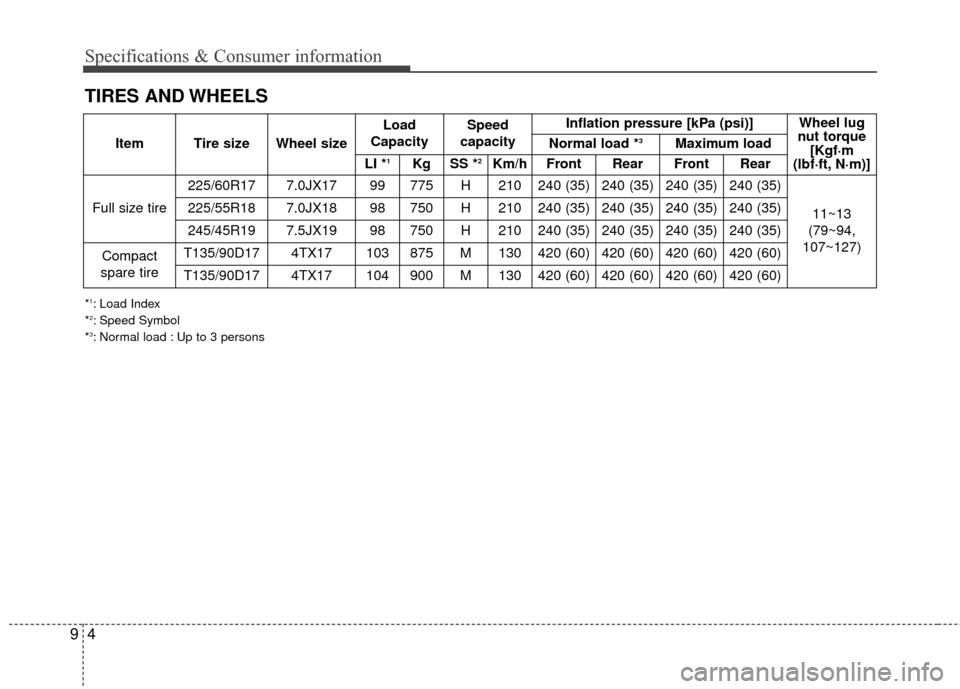
49
Specifications & Consumer information
TIRES AND WHEELS
*1: Load Index
*2: Speed Symbol
*3: Normal load : Up to 3 persons
ItemTire sizeWheel size
Load
CapacitySpeed
capacityInflation pressure [kPa (psi)]Wheel lug
nut torque [Kgf·m
(lbf·ft, N·m)]
Normal load *3Maximum load
LI *1KgSS *2Km/hFront RearFront Rear
Full size tire
225/60R177.0JX1799775H210240 (35)240 (35)240 (35)240 (35)
11~13
(79~94,
107~127)225/55R187.0JX1898750H210240 (35)240 (35)240 (35)240 (35)
245/45R197.5JX1998750H210240 (35)240 (35)240 (35)240 (35)
Compact
spare tireT135/90D174TX17103875M130420 (60)420 (60)420 (60)420 (60)
T135/90D174TX17104900M130420 (60)420 (60)420 (60)420 (60)
Page 579 of 595
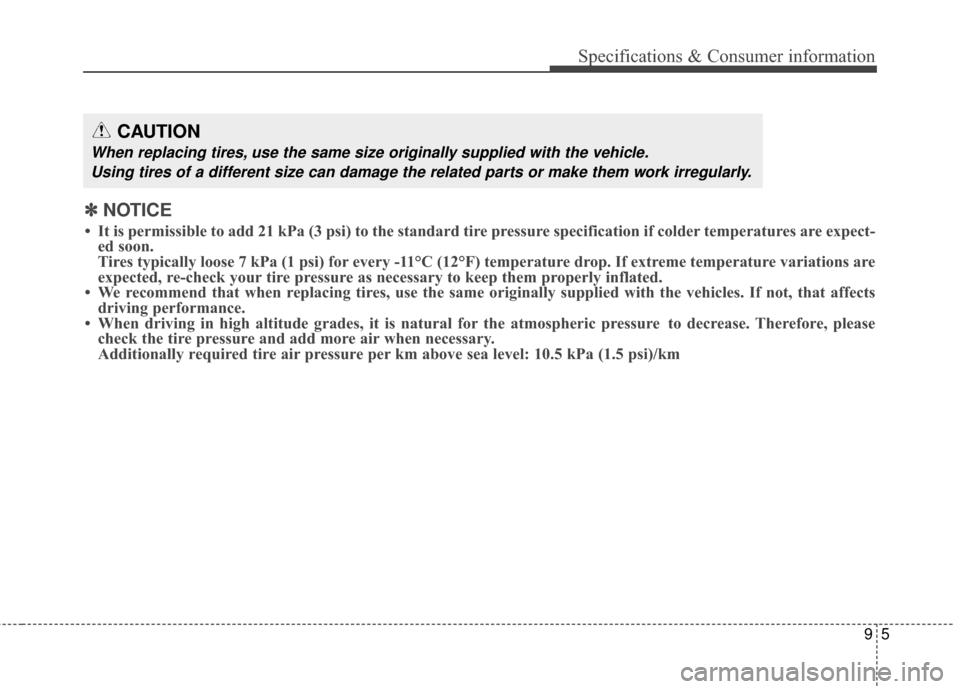
95
Specifications & Consumer information
CAUTION
When replacing tires, use the same size originally supplied with the vehicle.Using tires of a different size can damage the related parts or make them work irregularly.
✽ ✽ NOTICE
• It is permissible to add 21 kPa (3 psi) to the standard tire pressure specification if colder temperatures are expect-
ed soon.
Tires typically loose 7 kPa (1 psi) for every -11°C (12°F) temperature drop. If extreme temperature variations are
expected, re-check your tire pressure as necessary to keep them properly inflated.
• We recommend that when replacing tires, use the same originally supplied with the vehicles. If not, that aff\
ects driving performance.
• When driving in high altitude grades, it is natural for the atmospheric pressure to decrease. Therefore, please check the tire pressure and add more air when necessary.
Additionally required tire air pressure per km above sea level: 10.5 kPa (1.5 psi)/km
Page 580 of 595
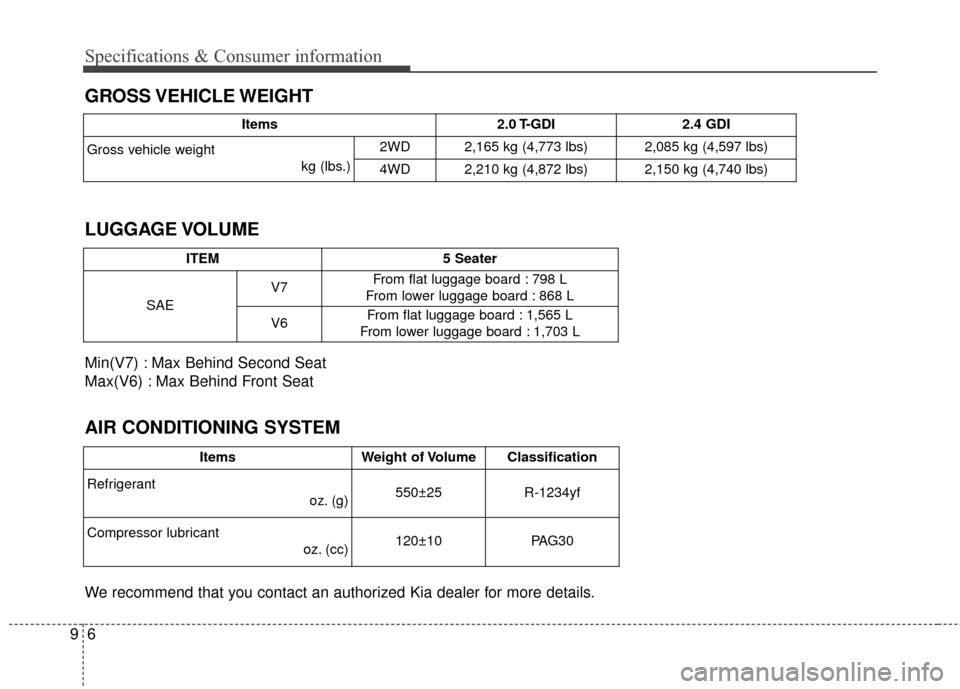
69
Specifications & Consumer information
GROSS VEHICLE WEIGHT
AIR CONDITIONING SYSTEM LUGGAGE VOLUME
We recommend that you contact an authorized Kia dealer for more details. Min(V7) : Max Behind Second Seat
Max(V6) : Max Behind Front Seat
Items2.0 T-GDI2.4 GDI
Gross vehicle weightkg (lbs.)2WD2,165 kg (4,773 lbs)2,085 kg (4,597 lbs)
4WD2,210 kg (4,872 lbs)2,150 kg (4,740 lbs)
ITEM5 Seater
SAE
V7From flat luggage board : 798 L
From lower luggage board : 868 L
V6From flat luggage board : 1,565 L
From lower luggage board : 1,703 L
ItemsWeight of VolumeClassification
Refrigerant oz. (g)550±25R-1234yf
Compressor lubricantoz. (cc) 120±10PAG30